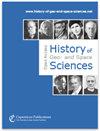极光氢排放:历史调查
IF 0.4
4区 哲学
Q4 GEOSCIENCES, MULTIDISCIPLINARY
引用次数: 3
摘要
摘要极光光谱学为遥感高纬度电离层的组成和动态提供了第一个工具。1885年,巴尔默发现可见的氢光谱由一系列离散的谱线组成,这些谱线的波长遵循一个简单的数学模式,这是开发这种工具的第一步。1939年10月18日,拉尔斯·维加德发现了巴尔默系列发射的Hα (656.3 nm)和Hβ (486.1 nm)光谱线,这些光谱线来自位于极光带赤道方向的扩散结构。N2+强烈的第一正带几乎覆盖了Hα辐射。第二次世界大战后,有了更先进的仪器,极光光谱学家维加德、加特林和迈尼尔研究了极光氢发射的其他特征。巴尔默系列的前三条线,包括410纳米的Hγ,是在太空时代之前通过地面测量确定的。在卫星观测的基础上,还检测到了410.13 nm和396.97 nm的巴尔默谱线Hδ和Hε,以及极紫外(EUV) Lymanα (121.6 nm)氢发射。20世纪40年代建立的氢发射的多普勒蓝移表明,发射粒子的能量很好地进入了千电子伏特范围,对应于速度bbb10 000 km s−1。在电子和质子产生的极光位置之间也建立了系统的空间分离。这些观测结果反过来表明,最终来自太阳的质子沉淀到顶层电离层,在那里它们与大气中的中性物质发生电荷交换。新生成的氢原子被留在激发态,并发出观察到的巴尔默辐射。探空火箭数据显示,大部分氢辐射来自105至120公里的高度。来自星载传感器的太空时代数据做出了两项重要贡献:(1)高能粒子探测器证明了磁层中存在与夜侧质子极光共轭的区域,在该区域存在打破千电子伏特质子第一绝热不变量的条件,允许它们通过填充的损失锥沉淀。(2) euv成像仪显示,日侧氢排放是对太阳风动压变化或行星际磁场南北分量极性变化的响应。本文章由计算机程序翻译,如有差异,请以英文原文为准。
Auroral hydrogen emissions: a historic survey
Abstract. Auroral spectroscopy provided the first tool for remotely sensing the
compositions and dynamics of the high-latitude ionosphere. In 1885,
Balmer discovered that the visible hydrogen spectrum consists of a series
of discrete lines whose wavelengths follow a simple mathematical pattern, which
ranks among the first steps toward developing this tool. On 18 October 1939
Lars Vegard discovered the Hα (656.3 nm) and Hβ (486.1 nm) spectral lines of Balmer series emissions, emanating from a diffuse
structure, located equatorward of the auroral zone. Intense, first
positive bands of N2+ nearly covered the Hα emissions. With more advanced instrumentation after World War II, auroral
spectroscopists Vegard, Gartlein and Meinel investigated other
characteristics of the auroral hydrogen emissions. The first three
lines of the Balmer series, including Hγ at 410 nm, were
identified in ground-based measurements prior to the space age. Based on
satellite observations, the Balmer lines Hδ and Hε at 410.13 and 396.97 nm, respectively, as well as extreme ultraviolet (EUV) Lyman
α (121.6 nm) hydrogen emissions, were also detected. Doppler blue shifts in hydrogen emissions, established in the 1940s,
indicated that emitting particles had energies well into the kiloelectron volt range,
corresponding to velocities >1000 km s−1. Systematic spatial
separations between the locations of electron- and proton-generated aurorae
were also established. These observations in turn, suggested that protons,
ultimately of solar origin, precipitate into the topside ionosphere, where
they undergo charge-exchange events with atmospheric neutrals. Newly
generated hydrogen atoms were left in excited states and emitted the
observed Balmer radiation. Sounding rocket data showed that most of the
hydrogen radiation came from altitudes between 105 and 120 km. Space-age data from satellite-borne sensors made two significant
contributions: (1) energetic particle detectors demonstrated the existence
of regions in the magnetosphere, conjugate to nightside proton aurora, where
conditions for breaking the first adiabatic invariants of kiloelectron volt protons
prevail, allowing them to precipitate through filled loss cones. (2) EUV
imagers showed that dayside hydrogen emissions appear in response to changes
in solar wind dynamic pressure or the polarity of the north–south component
of the interplanetary magnetic field.
求助全文
通过发布文献求助,成功后即可免费获取论文全文。
去求助
来源期刊

History of Geo- and Space Sciences
GEOSCIENCES, MULTIDISCIPLINARY-HISTORY & PHILOSOPHY OF SCIENCE
CiteScore
1.50
自引率
33.30%
发文量
10
审稿时长
50 weeks
期刊介绍:
The scope of History of Geo- and Space Sciences (HGSS) is to document historical facts and knowledge and to improve awareness of the history of geoscience. The knowledge of the development of geosciences and their experimental methods and theories in the past can improve our current understanding and may stimulate current research. It is encouraging for young scientists to read biographical material of historical figures in their research area. It is important as well to learn that history of science is an integrated part of the ongoing research in their research area. Another important aim of the journal is the association of historical retrospective and current research.
 求助内容:
求助内容: 应助结果提醒方式:
应助结果提醒方式:


